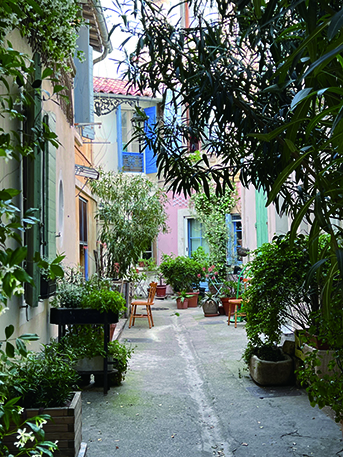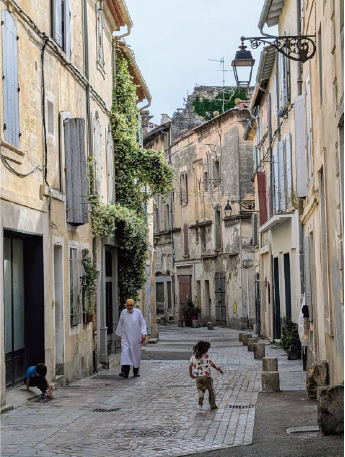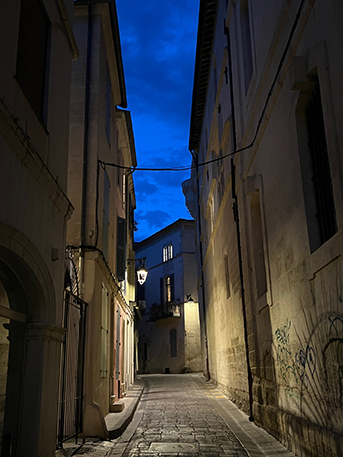30年かけて日本が失ったものをプロヴァンスで見つけた。
Column|2025.6.24
Text_ Toshinori Okada
Photo_Toshinori Okada
日本でバブル景気が終わろうかという頃、プロヴァンスブームというものがあった。フランス南部のプロヴァンス地方、そこにある田園風景やスローな暮らしぶりが憧れとなった。経済社会に煽られて、バブルに浮き足立ち、ディスコのお立ち台に上がり扇子を振っていたような日々に、みんな疲れだしていたのかも知れない。
「南仏風」や「南フランス流」といったキーワードが「フィガロジャポン」や「クロワッサン」といった女性誌にあふれ、ナチュラルで素朴なインテリア、ラタトゥイユやブイヤベースといった料理、オリーブオイルやハーブなどの素材も注目されるようになった。
そんなプロヴァンスブームの人気に火をつけたのがピーター・メール著「南仏プロファンスの12ヶ月」の世界的ベストセラー。プロヴァンス地方に移住したイギリス人作家の一年間を描いたこの本には、南仏の豊かな食材と食習慣、そして季節感にあふれた日常などが描かれていた。
この頃から、アヴィニヨンやアルルへと旅する人が急増。ラベンダーの香り袋や石けん、花模様がプリントされたランチョンマットなど 、似たようなお土産をいくつももらって困ったこともある 。女性の憧れの旅行先として、プロヴァンス地方はイタリアのトスカーナ地方と人気を二分していた。
あれから30年ほど経った今、アルルとアヴィニヨンへ行ってみた 。どちらも街の有り様は変わらない 。石造りの家 、豊かな緑 、穏やかな空気感。そこに南仏のきらめく陽光が降り注ぐ、相変わらず魅力的な場所だ。でもひとつ大きな違いがある、それは日本人がいないこと。
プロヴァンスに二泊三日滞在して出会った日本人は、高校の修学旅行の団体のみ。プロヴァンスだけではない、パリでも日本人を見ることは希になった。この30年で、日本の何が変わったのか。円安なうえに物価高で海外旅行に行く気もなくなる。しかし一方で、ツアーではビジネスクラス利用のコースがよく売れるという。格差、という言葉がちらつき、なんだかもやもやする。コスパやタイパに気を取られ、勢いと好奇心がなくなった国はどこへ向かうのか、少し心配。
In Provence, I Found What Japan Lost Over the Past 30 Years.
Toward the end of Japan’s bubble economy, a “Provence boom” swept the country. People were drawn to the region’s rural scenery and unhurried lifestyle—perhaps tired of the excesses of the era: frenzied disco nights, podium dancing, and waving folding fans.
Magazines like Figaro Japon and Croissant were filled with buzzwords like “southern French style,” featuring rustic interiors, dishes
like ratatouille and bouillabaisse, and ingredients like olive oil andherbs.
The boom was sparked by the global bestseller A Year in Provence by Peter Mayle. The book chronicled the British writer’s first year in Provence, painting a vivid picture of southern France’s rich ingredients, food culture, and seasonal rhythms.
so many lavender sachets, soaps, and floral placemats from friends returning from Provence that I didn’t know what to do with them all. For many women, Provence rivaled Tuscany as the ultimate dream destination.
Now, some 30 years later, I visited Arles and Avignon again. The towns remain much the same—stone houses, lush greenery, peace. Under southern France’s glittering sunlight, they are as enchanting as ever. But one thing was different: no Japanese tourists.
In three days in Provence, the only Japanese I saw were a group of high schoolers on a class trip. Not just here—even in Paris, Japanese tourists have become a rare sight. What happened to Japan over these past 30 years?
With a weak yen and rising prices, many have lost interest in trips abroad. Yet luxury tours are selling well. The word “inequality” lingers in the air, leaving an uneasy feeling. In a country now fixated on cost-efficiency and time-saving, I can’t help but wonder—what happened to our spontaneity and sense of wonder?

緑豊かなプロヴァンスの暮らし。

カフェでの会話は欠かせない。

石造りの街にスローな日常がある。

中世から時間が止まっているよう。


